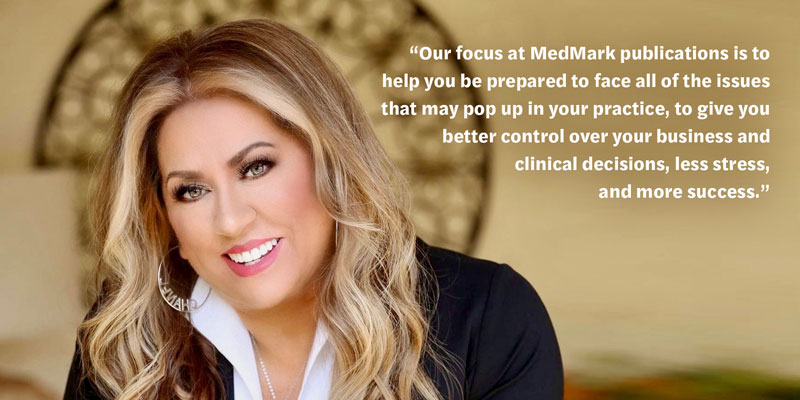Publisher Lisa Moler offers some tips on how to be prepared for changes and challenges so you can still thrive in the future.

Droughts, heat waves, rain, hurricanes, blizzards, tornadoes, wildfires, and earthquakes, or beautiful sunshine — no matter where you live in the U.S., the weather can bring you the bliss of sitting by the pool or bring you scurrying into the safest windowless room for cover. It’s not just the weather’s fluctuations that we need to prepare for — hoping for the best while preparing for the worst is the best way to avoid storms in all aspects of life. Our focus at MedMark publications is to help you be prepared to face all of the issues that may pop up in your practice, to give you better control over your business and clinical decisions, less stress, and more success.
Here are three tips on keeping your head above water, when you feel that flood of anxiety from practice stress.
- Pinpoint your stressors: Define what in your practice is keeping you awake at night, and maybe even keep a journal of what is causing you stress at the end of each work day. Are you afraid that your computer systems aren’t secure from cyberattacks? Are you unsure that your equipment is providing the specific information you need to get the best diagnostics? Are you frustrated that you cannot offer the latest treatment opportunities? Before you can fix a problem, you have to be sure of what the problem actually is.
- Establish a practice culture: Make sure that your practice handbook specifically outlines what behaviors and attitudes are acceptable and which will not be tolerated. Have weekly or monthly team meetings to make sure everyone is on the same page. To head off problems before they grow, learn about conflict resolution skills or hiring-and-firing protocols. If you have an office manager, remember to include him/her in these learning opportunities, and make sure your team knows that you are available for the more complicated situations.
- Give yourself the edge over the competition: It is stressful to watch potential patients filling up other dentists’ appointment calendars. In this day of the Internet and technology, you need to reassess your equipment to improve efficiency, accuracy, and increase patient care and options. Especially in this age of social media, you want your patients to see that you, rather than the clinician across the street, have the most up-to-date imaging, more painless protocols, or faster treatment options.
MedMark publications can help you discover what innovations have been developed and how they pertain to your specialty. In our winter issue, the Cover Story, “The Mainstreaming of Oral Appliance Therapy,” tells the interesting evolution of the new K1027 billing code which was sparked by the design and manufacturing innovations of the Slow Wave DS8 oral appliance. In our CE, “Is Your Mouthwash Putting You at Risk for Hypertension and Cardiovascular Disease?” by Nathan S. Bryan, PhD, explores the role of nitric oxide protecting the body against inflammation and resulting diseases. Our Clinical Focus, “An OMD Assessment with TMD Muscle Pain: A Case Study,” shows how myofunctional therapy resulted in a patient’s ability to open his jaws with full range of motion and achieve his goal of being able to enjoy some of his favorite foods again.
In this last issue of 2024, we give you our “umbrella wish” for fair weather, a dedicated and efficient team, a growing loyal patient list, less stress, and more fulfillment of your goals in the coming year.
Remember, every storm passes, and you need to be prepared to make intentional, positive decisions for a stronger and more profitable future. To your best success!
Lisa Moler shows how the determination to be prepared for changes and put your new ideas into action can bring positive movement to a practice. Read, “By Changing Nothing, Nothing Changes,” here: https://dentalsleeppractice.com/by-changing-nothing-nothing-changes/




